Marrying Vega and Zen: The AMD Ryzen 5 2400G Review
by Ian Cutress on February 12, 2018 9:00 AM ESTBenchmarking Performance: CPU Encoding Tests
One of the interesting elements on modern processors is encoding performance. This includes encryption/decryption, as well as video transcoding from one video format to another. In the encrypt/decrypt scenario, this remains pertinent to on-the-fly encryption of sensitive data - a process by which more modern devices are leaning to for software security. Video transcoding as a tool to adjust the quality, file size and resolution of a video file has boomed in recent years, such as providing the optimum video for devices before consumption, or for game streamers who are wanting to upload the output from their video camera in real-time. As we move into live 3D video, this task will only get more strenuous, and it turns out that the performance of certain algorithms is a function of the input/output of the content.
All of our benchmark results can also be found in our benchmark engine, Bench.
7-Zip 9.2: link
One of the freeware compression tools that offers good scaling performance between processors is 7-Zip. It runs under an open-source licence, is fast, and easy to use tool for power users. We run the benchmark mode via the command line for four loops and take the output score.
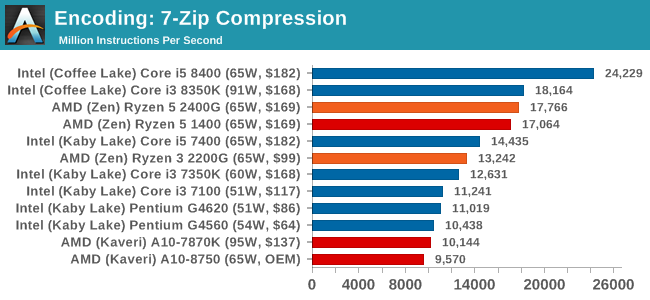
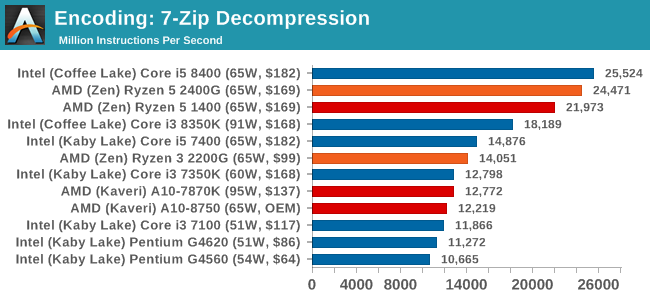
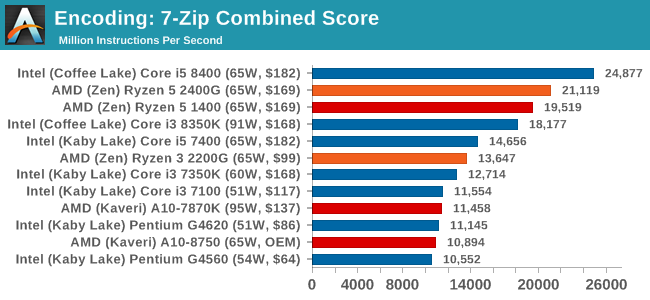
7-zip gives two contrasting stories here. For compression, full cores are needed to get the best performance, with frequency helping as well. However, for decompression, the extra threads help a lot. The combined result looks more like the decompression score, with the Ryzen 5 2400G sitting between the six-core Core i5-8400 and the quad-core Core i3-8350K.
WinRAR 5.40: link
For the 2017 test suite, we move to the latest version of WinRAR in our compression test. WinRAR in some quarters is more user friendly that 7-Zip, hence its inclusion. Rather than use a benchmark mode as we did with 7-Zip, here we take a set of files representative of a generic stack (33 video files in 1.37 GB, 2834 smaller website files in 370 folders in 150 MB) of compressible and incompressible formats. The results shown are the time taken to encode the file. Due to DRAM caching, we run the test 10 times and take the average of the last five runs when the benchmark is in a steady state.
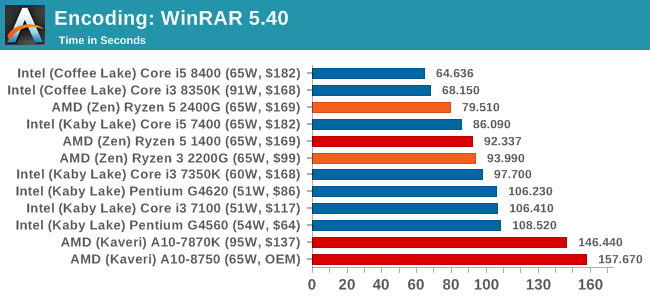
WinRAR is a good scaler with cores, frequency, and memory performance. The eight threads and DDR4-2933 contributes a good amount to the performance here, especially in light of where AMD was. The jump from the Ryzen 5 1400 to the 2400G is also noticable, due to the uptick in frequency and memory speed. The high single-thread performance of the Intel cores still wins out, however.
AES Encoding
Algorithms using AES coding have spread far and wide as a ubiquitous tool for encryption. Again, this is another CPU limited test, and modern CPUs have special AES pathways to accelerate their performance. We often see scaling in both frequency and cores with this benchmark. We use the latest version of TrueCrypt and run its benchmark mode over 1GB of in-DRAM data. Results shown are the GB/s average of encryption and decryption.
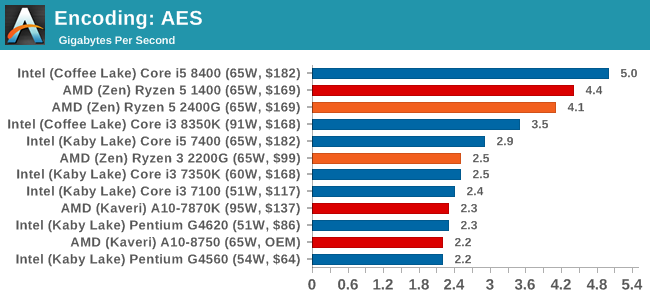
HandBrake v1.0.2 H264 and HEVC: link
As mentioned above, video transcoding (both encode and decode) is a hot topic in performance metrics as more and more content is being created. First consideration is the standard in which the video is encoded, which can be lossless or lossy, trade performance for file-size, trade quality for file-size, or all of the above can increase encoding rates to help accelerate decoding rates. Alongside Google's favorite codec, VP9, there are two others that are taking hold: H264, the older codec, is practically everywhere and is designed to be optimized for 1080p video, and HEVC (or H265) that is aimed to provide the same quality as H264 but at a lower file-size (or better quality for the same size). HEVC is important as 4K is streamed over the air, meaning less bits need to be transferred for the same quality content.
Handbrake is a favored tool for transcoding, and so our test regime takes care of three areas.
Low Quality/Resolution H264: Here we transcode a 640x266 H264 rip of a 2 hour film, and change the encoding from Main profile to High profile, using the very-fast preset.
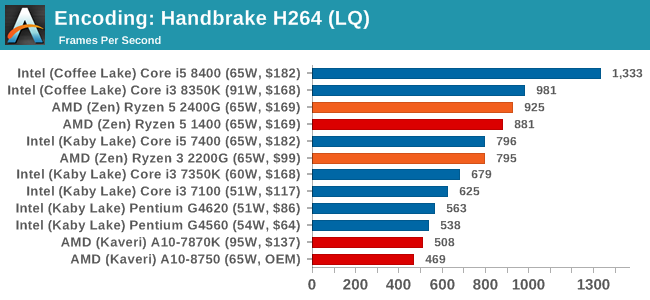
High Quality/Resolution H264: A similar test, but this time we take a ten-minute double 4K (3840x4320) file running at 60 Hz and transcode from Main to High, using the very-fast preset.
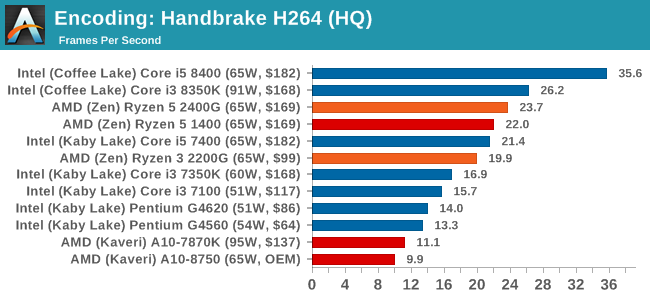
HEVC Test: Using the same video in HQ, we change the resolution and codec of the original video from 4K60 in H264 into 4K60 HEVC.
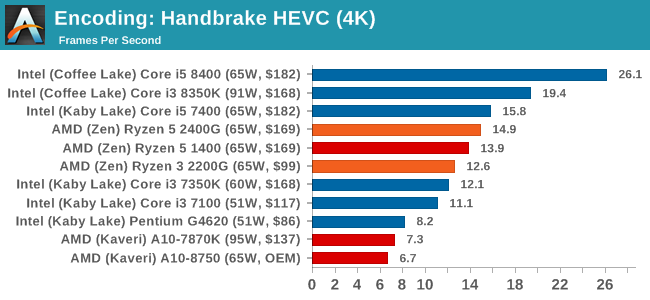










177 Comments
View All Comments
nevcairiel - Tuesday, February 13, 2018 - link
Some more realistic gaming settings might be nice. Noone is going to play on settings that result in ~20 fps, and the GPU/CPU scaling can tilt quite a bit if you reduce the settings.I can see why you might not like it, because it takes the focus away from the GPU a bit and makes comparisons against a dGPU harder (unless you run it on the exact same hardware, which might mean you have to re-run it every time), but this is a combined product, so testing both against other iGPU products would be useful info.
atatassault - Tuesday, February 13, 2018 - link
20 FPS is playable. I have a 2 in 1 with a Skylake i3-6100u, and 20 FPS is what it gets in Skyrim. Any notion of things being "unplayable" under 30/60 FPS is like an audiohile saying songs are unlistenable on speakers less than $10,000.lmcd - Tuesday, February 13, 2018 - link
Any notion of things being "unplayable" under 30/60 FPS is like an audiophile saying songs are unlistenable on speakers less than $100.Fixed it for you (FIFY).
nevcairiel - Thursday, February 15, 2018 - link
I rather reduce settings a bit to go up in FPS then look at 20 fps average. There often is many things one can turn off without a huge visual impact to achieve much better performance.29a - Saturday, October 26, 2019 - link
What a useless review. I came here to see if this thing can do some low end gaming and you didn't even test on 720p.Gideon - Tuesday, February 13, 2018 - link
Yes sorry, I didn't mean to nitpick. Just being a web developer myself dealing mosrly with frontend code, I just wanted to mention that Speedometer is actually considered to be fairly representative by both Mozilla and Google (and true enough the frameworks they use are actual frontend JS frameworks rendering TodoMVC) If you are already aware of that then that's excellent.richardginn - Monday, February 12, 2018 - link
An article looking at how memory speed affects FPS on the 2400G and 2200G is s must.I say you can 1080P game with this although it looks like for a bunch of games you will be on low settings
stanleyipkiss - Monday, February 12, 2018 - link
Check out Hardware Unboxed's review on YouTube. They did just that.beginner99 - Tuesday, February 13, 2018 - link
Yeah this review should have used medium or low settings, something that is actually playable on the CPUs tested. 25 fps might work for Civ6 but not a shooter.iter - Monday, February 12, 2018 - link
Not too shabby, 2-3x the igpu perf of intel and comparable cpu perf in the same price range. And it will likely pull ahead even further in the upcoming weeks as faster memory becomes supported.